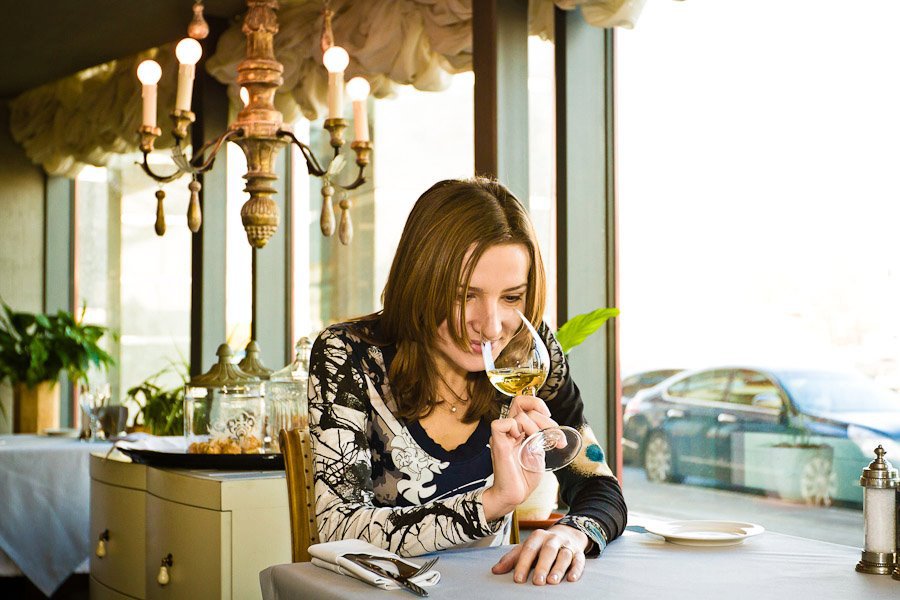Montenegro is an emerging market for the wine industry. We spoke to Eleonora Scholes, an international wine journalist, wine connoisseur and the Russian voice in the world of wine, who has been living in Italy since 2005. She spent a lot of time in Montenegro and has had the opportunity to learn the peculiarities of the Montenegrin wine industry and wine itself. Here is the full interview for your enjoyment.
#mnetoday: Eleonora, please tell us about yourself: What is your specialization? What are you busy with at the moment? How long have you been in the wine industry? Why are you interested in Montenegrin wines?
ES: I work with wine. To briefly describe my activities, I am a wine journalist, writer, taster, and consultant. Professionally I’ve been involved with wine for the past 15 years. It started as a hobby in the late 1990s and gradually evolved into a full-time job. My interest was sparked by travels in France and South Africa where I had some very memorable winery visits as a tourist. It was fortunate that my experience was shaped by high-quality wines from the very beginning. It was a great launching point for my career as a wine journalist and my interests quickly expanded to the wines of the whole world, from Europe to Chile to Australia. I’ve been tasting and writing about fine wines in both specialized publications and the lifestyle press, including Forbes and The World of Fine Wine. As an author, I contribute to Hugh Johnson’s Pocket Wine Book, which is the world’s bestselling wine guide with 11 million copies sold annually. I’ve also been a wine judge at various international competitions.
Another, very different aspect of my work was doing a business analysis of the Russian wine market. With a strong marketing background, a reputation as an independent wine expert and Russian as my mother tongue I could closely follow the market, presenting it at international business events and in the press.
My latest project is spaziovino.com which I’ve been publishing for the last 5 years. It is now a reference point for fine Italian wines and lifestyle in the Russian language. I’ve lived in Italy for the past 12 years and have come to know and love Italian wines more than any other. Spaziovino.com is created for consumers, so we try to write less about the technical side and more about culture, places, people and other lifestyle things which make Italian wine so appealing.
Now, what about the wines of Montenegro? I’ve been spending every summer in Montenegro since 2011. Naturally, I couldn’t miss the local wines. I worked as a wine consultant for Porto Montenegro, organizing tastings of Montenegrin wines. It was important to understand how wine production developed in Montenegro.
Historically local wine production was monopolized by Plantaže, which was run by the state. Plantaže remains the market leader, but new private wineries are emerging who are aiming for high quality production. It is an exciting time for Montenegro.
#mnetoday: Whenever people go to the restaurant in Montenegro and order a glass of wine, they are usually offered Croatian or Montenegrin wine. How does one choose a wine?
ES: Choosing wine in a restaurant may be challenging. People feel uncomfortable going through a list of unknown labels. They fear that they may pay too much for something that they will not appreciate. Really, it shouldn’t be like this. Choosing the right wine for your dinner is not difficult. It is all about common sense. Wine serves as an accompaniment to food and contributes to your overall dining experience. These factors are more important for enjoying your wine than, say, choosing a bottle only because of its prestigious label.
There are no fixed rules for which wine goes best with what food. Yes, there are some generally accepted matches, but they are not dogmas. You may enjoy light summer foods with lighter wines, such as unoaked white, rosé or red, or you may have a grill with a robust Vranac or big oaked Chardonnay, but in the end of the day it is your palate and your personal preference that will say what works best for you.
When you are in a fine restaurant, don’t be afraid to ask the sommelier questions about wines. I do it when I see an unknown wine and want to find out its general style, whether it is aromatic, light- or full-bodied, oaked or unoaked, very tannic or not, and so on. Another important thing to keep in mind is the vintage, or the year of harvest. For lighter, easy-going wines, especially white and rosé, the vintage should be recent. More structured wines, especially tannic reds, such as high quality Cabernet Sauvignon or Vranac, benefit from some aging. All this information helps to make a smart choice in the restaurant and minimizes the risk of getting the wrong wine for your food or your general taste preference.

#mnetoday: What is a wine consuming culture and does it exist in Montenegro?
ES: Wine culture is common in countries with long traditions of winemaking. Think of France, or Italy, or Spain. Wine is an essential part of the diet in these countries. It is also part of the general lifestyle. Wine means socializing, keeping good company, having a good time. Note that wine is not about being drunk. You don’t see people drinking wine to get deliberately drunk there. Drinking too much and not being able to control yourself is viewed as bad manners in these countries. It is also a part of a real wine culture.
Montenegro is a bit of a paradox. Being a Mediterranean country and having many vineyards, Montenegro should have a great wine culture. In reality it is not so. Montenegro’s national drink is rakija, or brandy. The most common is lozova rakija which is produced from grapes. Montenegrins are very proud of their rakija. Historically wine has not been so prestigious, it was viewed as a secondary drink after rakija. That’s why the wine culture is not as strong in Montenegro. But things are changing. Wine is becoming a more important lifestyle drink, especially at the seaside resorts. Wine is viewed as a classy, sophisticated drink. It is a prime choice among guests at high-end hotels and restaurants.
[quote]…winemakers should take pride in Vranac and other quality local varieties. They show the authentic side of Montenegro; they are something that cannot be found in the rest of the world. The ambition should be to take these grapes to new heights, to produce fine wines which can impress the world.[/quote]
#mnetoday: How many vineyards are there in Montenegro and what is their distribution?
ES: The Statistical Office of Montenegro gives the figure of over 4 500 hectares of vineyards which is impressive for a small country. I estimate that commercial wine production accounts for around 2 500 hectares. Plantaže is by far the largest, with over 2 300 hectares. Few wineries in Europe have such gigantic vineyard holdings. Other commercial wineries in Montenegro are small to medium in size, normally between 3 and 20 hectares.
When you fly in or out of Podgorica, you cannot fail to see a great plain of vineyards close to the airport. This is one of the main winegrowing centers, between the capital and Skadar Lake. Most of these vineyards belong to Plantaže. Another important area is the Crmnica Valley, between Skadar Lake and the Adriatic coast where Vranac is historically grown. There are also small vineyards in other parts of Montenegro, they are scattered all over the country.
#mnetoday: What types of grapes are popular in Montenegro?
ES: You can find both local and international varieties in this country. The one that really distinguishes Montenegro is Vranac (pronounced VRA-nats). It is an indigenous red grape which dominates in the Montenegrin vineyards and can also be found in some neighboring countries. Vranac is translated as a black stallion, and it is truly the leading horse of Montenegrin winemaking. Vranac is related to Crljenak Kaštelanski from Croatia (the same grape is cultivated as Kratošija in Montenegro, Primitivo in Southern Italy and Zinfandel in the USA).
Vranac is perfectly adapted to poor stony soils, summer heat and the sunny Mediterranean climate. It makes a generous wine, with a rich dark color, full body, high concentration of dark fruit flavors and wonderful notes of Mediterranean scrub and minerals. Though the wine is big and bold, it has a lot of freshness which makes it great as a food companion for grilled meat and any hearty dishes. Vranac has the potential for making outstanding wines, yet this potential is not fully explored. Most available Vranac wines are made in an approachable, quite simple style. To get an idea what real Vranac can offer, try Plantaže Vranac Reserve (from the ultra-premium range) or the wines of Radevic Estate.
A local white grape of note is Krstac which makes a lively, refreshing wine. It is not complex, but it goes well as an aperitif or for light fish and seafood dishes in the summer season.
There are some other local varieties, but their production is negligible and almost impossible to find.
Among the international varieties, Chardonnay, Merlot and Cabernet Sauvignon are common. In my view Syrah can yield exciting results in Montenegro.

#mnetoday: Can you describe the process of wine making in this region? Are there any peculiarities of wine production here?
ES: Generally speaking, the production of wine is conservative. It follows the same basic stages regardless of whether the wine is made in Montenegro, or France, or Australia. For white wines, grapes are destemmed and pressed. The juice is separated from the skins and the pips and transferred to vats where it undergoes alcoholic fermentation. For red wines, the skins and pips are left in the juice after pressing. That is necessary to extract the color and tannins. After the alcoholic fermentation wine may be left for further aging. This is the winemaker’s choice. The aging can be long or short, it can take place in a neutral environment (steel vats or bottles) or in oak barrels.
#mnetoday: How profitable is wine making in Montenegro? How much do wineries earn here?
ES: Winemaking is definitely not a business where you can expect a quick return on an investment, if you start from zero. It takes at least 4-5 years to make any money. Consider this – you need to prepare the soil, plant a vineyard, wait a minimum of 3 years until the vines start to bear grapes suitable for wine production. Then you spend another 6-8 months for vinification if the wine is not aged, or up to 2-3 years and more if you choose to leave your wine in the cellar for aging. Only after that, can you start to sell the first bottles. Setting up a new winery requires a considerable investment – in vineyards, in winery equipment, in human resources, in sales and marketing.
Winery owners with serious intentions for high-quality production view their projects as long term. They normally have another business that allows them to finance their winemaking without the pressure of immediate returns. I’ve seen a couple of such wineries in Montenegro, with state-of-the-art equipment, where prices for wine do not cover production costs or have a tiny profit margin, otherwise, they would be too expensive for the market. In the longer term a winery, of course, cannot afford to be loss-making, but again, this is a slow agricultural business where you have to work hard to be financially rewarded, and where you can never expect to be fabulously rich.

#mnetoday: How popular are the wines of Montenegro abroad?
ES: Montenegrin wines are hardly known abroad. It is partly because wine production in Montenegro is tiny on a global scale. Bordeaux alone has over 100 000 hectares of vineyards. Chianti vineyards in Italy cover over 20 000 hectares. Many countries make wine, and the international competition is fierce. These days it is not enough just to make quality wine and hope that it will automatically build a reputation for itself. Export, promotion and communication are the keys to international success. At the moment Plantaže is the ambassador for Montenegrin winemaking. I am aware that an association of Montenegrin winegrowers and wine producers exists, but I am not sure if they do any promotional activities at home or abroad.
#mnetoday: In general, what producers, on the global market, do customers prefer?
ES: As mentioned earlier, Plantaže is the market leader. I don’t think its position will change any time soon. Small private wineries cannot compete with Plantaže on volumes, but they can differentiate themselves through an artisanal approach, through making wines which reflect their genius loci, the spirit of the place where they come from. At the moment, I would highlight Radevic Estate and Savina as wineries that are seriously working in this direction.
#mnetoday: What is the future potential for Montenegro on the wine market?
ES: Wine tourism is a proven way to attract attention to Montenegrin winemaking. Some wineries are already open to the public, they do winery tours and tastings and even offer accommodation. Wine tours are a great addition to the beach holidays, for which Montenegro is famous. If organized well, winery visits are a special experience. People remember them long after the holidays. And, importantly, they can be a great tool to get new customers and boost sales.
As for winemaking in general, I believe that winemakers should take pride in Vranac and other quality local varieties. They show the authentic side of Montenegro; they are something that cannot be found in the rest of the world. The ambition should be to take these grapes to new heights, to produce fine wines which can impress the world.
#mnetoday:
#mnetoday: What are you the most curious about today?
ES: A very timely question! Until recently I’ve been mostly immersed in the topic of wine. The more you know about wine the more you realise how much you don’t know. It’s a bottomless topic, from grapes to people, from farming to art, from purely technical aspects to the philosophical side of making wine. You learn every day. But you can’t do wine all the time. There are so many other great things in life. I am very interested in literature and art. I have just finished a Harvard course on the masterpieces of world literature. It included selected works starting from the Epic of Gilgamesh, written four thousand years ago, to modern literature. Reading Orhan Pamuk, a contemporary Turkish writer, was a revelation. Now I am studying Dante’s Divine Comedy which is the most challenging literary work I’ve ever read!
#mnetoday: Who has been your greatest inspiration?
ES: I admire people who stand by their beliefs and principles, but who are open to the world. I love elegance. Beatrice d’Este is one of the historic people close to my heart. She was a great lady of the Italian Renaissance. She was the wife of Ludovico Sforza, the duke of Milan. Largely thanks to her Milan had one of the most splendid courts of its time. Beatrice was a great patron of art. She was well educated and had fine taste, and she was also very shrewd politically, helping her husband to establish his power.
#mnetoday: If you had the chance to start your career over again, what would you do differently?
ES: I would write a book on Italian wine! But I think I still have an opportunity to do that.
#mnetoday: What is your most treasured possession?
ES: Life itself. Being human, experiencing our extraordinary world is the greatest gift I could ever have.


